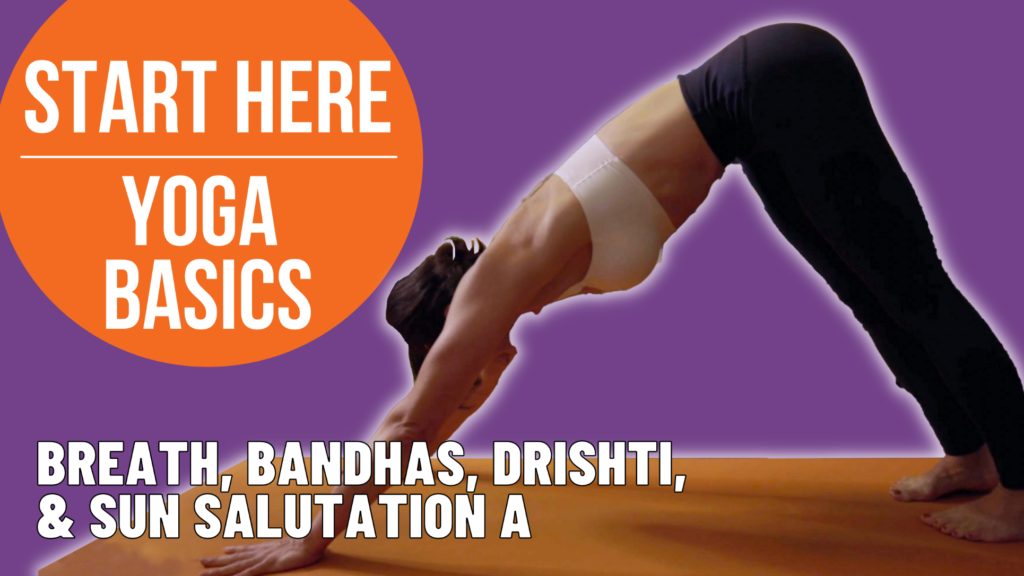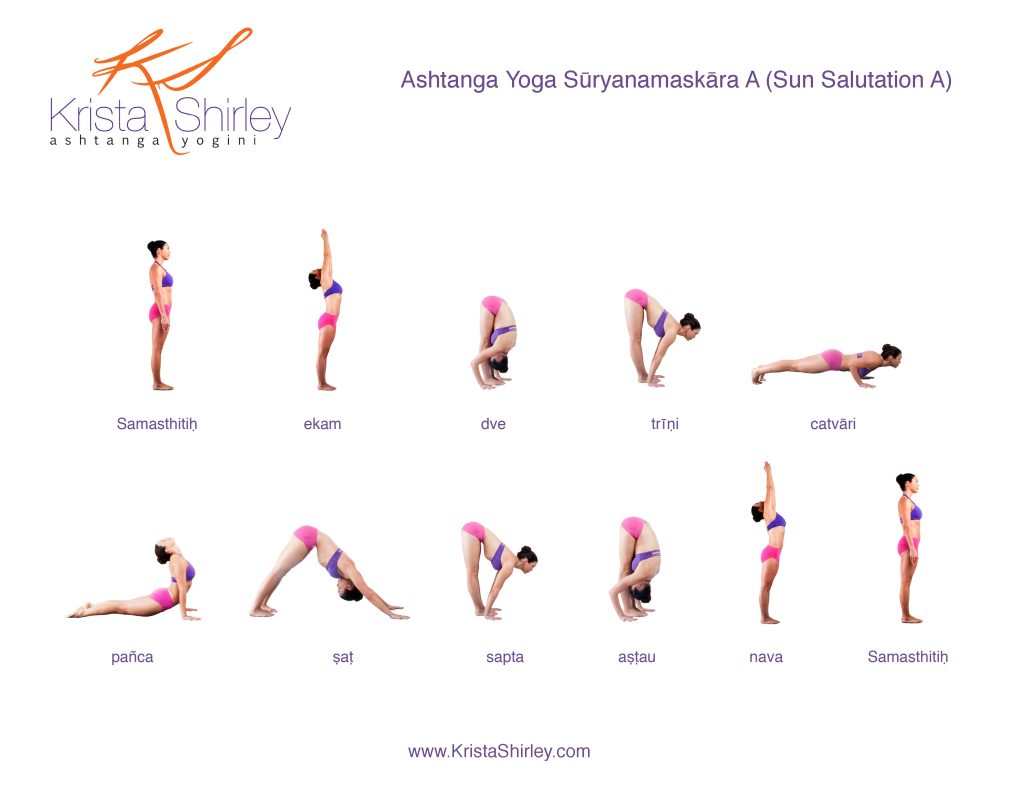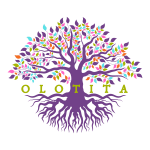Welcome to Olotita’s Yoga Asana Series for building or maintaining an at home Ashtanga Yoga practice. Today we explore the foundational principals of the Ashtanga Yoga system.
The foundational components of Ashtanga Yoga include breathing, bandhas and drishti.
Asht-anga means eight-limbs. In this tradition we begin with the third limb, or asana. This is the physical movement portion of this eight-limbed practice.
To access Video #1 of this Yoga Asana Series, Tap HERE
Breathing
This particular yoga style focuses on breathing far more than any other tradition out there. We practice deep breathing with sound, which is sometimes referred to as Ujjayi breathing. This type of breathing consists of slow deep breathing from your throat through your nose. Unlike a bellows breath, you focus on drawing the air from your pelvic floor on your inhale, slowly drawing the breath up through your stomach, chest, lungs and diaphragm. The word happens at your throat but through your nose with your mouth closed. When doing it correctly you’ll feel a pleasant pulling sensation at your glottis. This is a vital part of the Ashtanga yoga practice and one that will take a long time to truly master.
As you begin this practice, just focus on keeping your mouth closed and focus on taking slow deep inhales and slow deep exhales from your throat. Over time, you’ll find you can maintain a steady breath throughout the duration of your practice.
Each yoga asana has a prescribed inhale or exhale, known as a vinyasa or breath with movement. In the beginning, though, simply make sure you are breathing continuously with your mouth closed, without holding your breath.
Bandhas
Bandhas are another vital component to the practice of Ashtanga Yoga. These are energy locks that are located in certain areas of your physical body. To engage these ‘energy’ locks, you must simply engage the area of the physical body in which they reside. While there are more than three bandhas, in Ashtanga yoga we focus on the three primary energy locks.
Mula or Moola Bandha
Mula Bandha is your root lock. It’s located at the base of your torso, or at the perineum. This is also where muladhara chakra resides. Activation or contraction of Mula Bandha is thought build prana, or internal energy. It is also touted to positively aid the respiratory, nervous, circulatory and endocrine systems in your body. You engage or activate this lock by squeezing your anal sphincter muscles on each and every inhale.
Uddiyana Bandha
Uddiyana Bandha is your navel lock. It’s located in the center of the abdomen. It’s a powerful lock that is felt in the stomach on every exhale. If you are doing deep breathing with sound correctly, you’ll feel Uddiyana Bandha engage while you expel the carbon dioxide from your body on your exhale. As you push the breath out from your nose, through your throat, you’ll feel your navel pressing towards your spine
Jalandhara Bandha
Jalandhara Bandha is your chin lock. Unlike the Mula and Uddiyana bandhas, the Jalandhara Bandha only comes into use several times during the Ashtanga Yoga Primary Series. It is located at the pit of your throat. To activate Jalandhara Bandha, simply lower your head and bring the skin of your chin to the skin of your chest. This lock is used primarily during Pranayama practice, or the 4th limb of Ashtanga Yoga.
When practiced together, the three locks are known as Maha Bandha, or the Great Lock.
Drishti
Drishti is your gaze or focus point during your yoga asana practice. Focus the eyes to the recommended gaze point (dristhi) in each asana. Drishti is intended to help you concentrate your mind on one steady point during the five breaths you take in each Ashtanga yoga posture. This will allow you to keep your focus internal, which will eventually lead to consistent focus on the bandhas, which will help unite the breath to everything.
Through the use of dristhi, slowly your detachment and awareness will grow, and over time your mind begins to move towards Oneness. Practicing, and mastering drishti during the asana practice helps prepare the practitioner for other limbs of Ashtanga yoga. The fifth limb, Pratyahara, or sense withdrawal; and the sixth limb, Dharana, or concentration.
In the Ashtanga yoga asana practice we utilize 8 gaze points:
- NASAGRAI (tip of nose)
- BROOMADHYA (third eye)
- NABI (naval)
- HASTAGRAI (hand)
- PADHAYORAGRAI (toes)
- PARSVA (gazing to the left/right)
- ANGUSTA MA DYAI (thumbs)
- URDHVA or ANTARA(looking upward)
Awareness builds organically through focus on dristhi, mental concentration on bandhas, Ujjayi breath, and asana. Through continuous practice, over time, you will naturally learn asana and maintain breath, allowing attention to be with your bandhas. In this way, over time, your thinking will decrease and you will move into the true purpose of Ashtanga Yoga…Moving Meditation.
Sun Salutation A
Sun Salutation A consists of nine (9) movements with breath, or vinyasa’s. Each posture in the Sun Salutation A sequence is intended to flow one into the other with one breath, except for position six (shat). Once you get to position six of the Sun Salutation, or downward facing dog, you’ll hold the asana for five deep breaths. After taking your fifth breath in down dog, you again flow breath by breath, or vinyasa, until you get back to where you started in Samasthitih.
Check out Olotita’s Yoga Asana Series video #1 to learn the Sun Salutation A sequence step by step with Krista Shirley. Krista will demonstrate modifications for each movement as well as the full expression of each movement that makes up Sun Salutation A. Then, she will walk you through the nine movement sequence several times to help you familiarize yourself with each step in Surya Namaskara A. This will help you get to the point you can do on your own without guidance and also help you learn the prescribed breathing for each movement.
The most ideal way to learn the Ashtanga yoga Sun Salutation’s is by going to a Mysore class with an Authorized teacher. However, if you don’t have a local shala near you, the second best option for you is the free Introduction to Ashtanga Yoga video by Krista Shirley on Olotita’s youtube channel.
We recommend you watch this video from start to finish the fist time you watch it. Additionally, Krista has added timestamps, listed on the youtube video description, for you to be able to refer back to whenever you want to work on a specific component such as breathing, bandhas, drishti, or Sun Salutation A. We hope you find this video series helpful to you in creating or maintaining your at home yoga practice!
Practice Aids
In addition to the free Youtube instructional video, we have additional practice aids to help you as you learn, work towards memorization and ultimate mastery of these postures. Krista’s Sun Salutation A practice cards, seen above, or Krista’s Ashtanga Yoga Primary and Intermediate series yoga poster are excellent yoga tools for your at home yoga practice.
Remember that your asana practice is a life long journey. The benefits are countless but the purpose is singular – achieving a true connectedness to this world.
About Krista Shirley
Krista Shirley is a level II authorized Ashtanga Yoga teacher and the founder of The Yoga Shala in Winter Park, Florida.
Krista’s dedication to her personal yoga practice shines through in her teaching. Her energy is contagious and inspiring! Krista specializes in meeting each student where they are. She’s able to help them create a habit of daily practice, learn the sequence of asanas and work towards physical mastery of the postures. Moreover, Krista’s intuitive teaching helps each student go inside themselves to truly integrate the body and mind. In turn this helps practitioners let go of the things in their lives that no longer serve them. Krista is here to help you begin or advance your Ashtanga Yoga journey and looks forward to sharing this transformational and enriching practice with you.
If you want to join Krista for in person classes or events, she runs a morning mysore style yoga program in Winter Park, Florida. If you would prefer personal one on one instruction, Krista offers virtual and in person private instruction. She also teaches workshops and retreats nationally and internationally. If you’d like to have her come to your studio or city, contact Krista.
Let’s Get Social
Be sure to signup for our newsletter to stay on top of local events and classes, Nysa products sales, new offerings, new products and more!
❤️Follow on Instagram
❤️Follow on Facebook
Other Youtube Videos with Krista You Might Enjoy
Story about Krista’s Scars:





